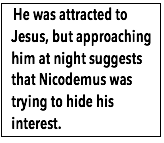One familiar sign
waved by spectators at sports events in hopes that television
cameras will transmit their message is: “John 3:16.” A
favorite of many Christians, this verse states: “God
so loved the world that he gave his only Son, so that everyone
who believes in him may not perish but have eternal life.”
Context of the Gospel
Torn from its context (the entire Gospel of John and the Johannine community),
this verse presents a heartwarming thought. The fuller literary context, as reported
in today’s reading, darkens the picture: “people loved darkness rather than
light” (Jn 3:19).
For John, the term “world” carries a negative meaning.
The world is at odds with Jesus (Jn 16:20; 17:14, 16; 18:36) and with his Spirit
(Jn 14:17; 16:8-11). Worse, it hates Jesus and those who believe in and follow after
him (Jn 7:7; 15:18-19; 16:20). That the inhabitants of the world preferred darkness
to light earns them the name “children of darkness” (Jn 12:35-36). For
this reason, Jesus refuses to pray for the world; instead, he defeats the world
(Jn 16:33).
 Contemporary Christians, like those who wave the “John 3:16” signs
at sporting events, ought to heed the caution of the eminent Johannine scholar
Raymond Brown, against the naiveté that this passage sometimes engenders.
The world is not exclusively neutral, nor is it patiently awaiting good news.
There are many who are actively hostile to Jesus, to Christianity and its message.
Encountering the disbelief of the “world” was a shocking experience
for the Johannine Christians. This knowledge should help their contemporary descendants
to be forewarned and forearmed. Contemporary Christians, like those who wave the “John 3:16” signs
at sporting events, ought to heed the caution of the eminent Johannine scholar
Raymond Brown, against the naiveté that this passage sometimes engenders.
The world is not exclusively neutral, nor is it patiently awaiting good news.
There are many who are actively hostile to Jesus, to Christianity and its message.
Encountering the disbelief of the “world” was a shocking experience
for the Johannine Christians. This knowledge should help their contemporary descendants
to be forewarned and forearmed.
Context of John 3
Today’s verses are selected from a more extensive discussion that Jesus had with
Nicodemus, a Pharisee and “ruler” or “religious authority” among
the Judeans of the house of Israel.
He was attracted to Jesus, but approaching him at night suggests that Nicodemus
was trying to hide his interest (Jn 3:2). Anyone at all familiar with the nosey
Mediterranean world where privacy is practically nonexistent can sympathize with
Nicodemus’ strategy to protect his reputation, his honor. Once ruined or lost,
a reputation or honor cannot be regained.
But the discussion reported and interpreted by John runs in a circle because
of Nicodemus’ apparent failure to understand Jesus’ use of a Greek word with
two meanings: “again” and “from above” (Jn 3:3-9). Nicodemus
typifies many who came to Jesus but had difficulty understanding him at first.
Some never understood him (see Jn 2:23-25).
To his credit, though, Nicodemus seems to have pondered and perhaps even pursued
his interest in Jesus further, no doubt in discussion with others in typically
Mediterranean, group-centered fashion. Later in the Gospel (Jn 7:37-44), Jesus’
statements in the Temple prompt a divided response in his audience. Some believe
in him, and others want to arrest him.
The chief priests and Pharisees are disappointed and taunt and insult the Temple
police for not arresting Jesus. At this moment, Nicodemus exposes himself to
shame by defending Jesus’ right to a hearing (Jn 7:50-51). Shame is not long in
coming: “Surely you are not also from Galilee, are you?” ask his fellow
Pharisees derisively. Nicodemus the night visitor has now gone one step further,
to daytime defender of Jesus, at least indirectly.
The final appearance of Nicodemus in John’s Gospel makes his spiritual journey
appear to be complete. When Jesus dies, Nicodemus comes forward publicly with
myrrh and aloes to anoint the body. He joins Joseph of Arimathea, a secret disciple
of Jesus who feared the Judeans, and both of them see to the burial of Jesus’
corpse (Jn 19:38-42).
This final appearance of Nicodemus illustrates Jn 3:14: “And just as Moses
lifted up the serpent in the wilderness, so must the Son of Man be lifted up
that whoever believes in him may have eternal life,” and Jn 12:32: “And
when I am lifted up from the earth, I will draw all people to myself.” Lent
is an opportune time to redirect one’s path to Jesus.
John
J. Pilch
|
John
J. Pilch is a biblical scholar and
facilitator of parish renewals.
Liturgical Press has published
fourteen books by Pilch exploring the
“cultural world” of the Bible.
Go to http://www.litpress.org/ to
find out more.
Copyright © 1997 by The Order of St.
Benedict, Inc., Collegeville, MN.
All rights reserved.
Used by permission from The
Liturgical Press, Collegeville,
Minnesota 56321
The complete text of the
above article can be found in:
The Cultural World of Jesus, Sunday by Sunday, Cycle B
John J. Pilch. The Liturgical Press. 1995. pp. 58-60.
Art by
Martin Erspamer, O.S.B.
from Religious Clip Art for the
Liturgical Year (A, B, and C).
Used by permission of Liturgy Training
Publications. This art may be reproduced
only by parishes who purchase the
collection in book or CD-ROM form. For
more information go to: http://www.ltp.org/
|
|